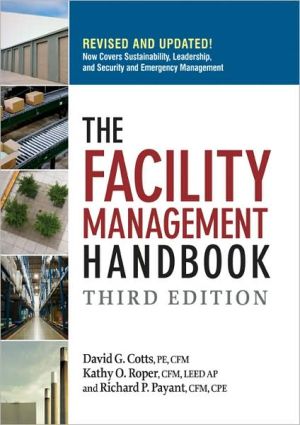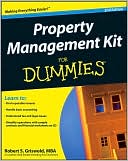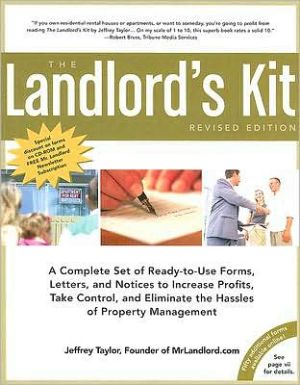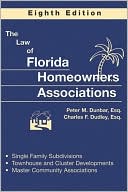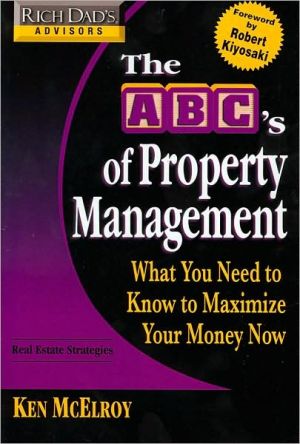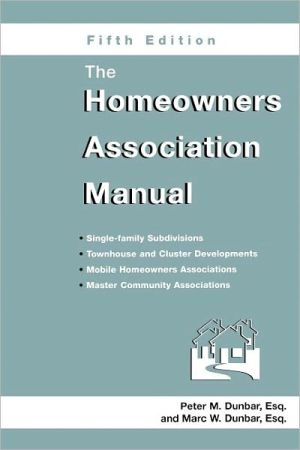Facility Management Handbook
Based on best practices and proven research, this thoroughly updated and revised edition of The Facility Management Handbook—the best-selling, most widely-used facility management book of all time—gives you powerful arguments and tools to bring to the business planning table, allowing you to demonstrate the enormous profit potential of your department, and secure your well-deserved leadership role in your organization.\ Packed with case studies and illuminating examples, this comprehensive...
Search in google:
Based on best practices and proven research, this thoroughly updated and revised edition of The Facility Management Handbook—the best-selling, most widely-used facility management book of all time—gives you powerful arguments and tools to bring to the business planning table, allowing you to demonstrate the enormous profit potential of your department, and secure your well-deserved leadership role in your organization.Packed with case studies and illuminating examples, this comprehensive resource covers a broad range of topics, from space planning and maintenance to benchmarking and outsourcing, supplying you with the background and techniques you need to:• Design, construct, and maintain facilities using sustainable practices. • Provide a safe, attractive work environment that supports productivity. • Assemble an excellent facility management team. • Plan and control capital expenditures. • Ensure that facility plans match organizational needs. • “Sell” facility management through commonsense public relations techniques. • Minimize construction litigation. • Reduce space renovation caused by “churn.” • Maintain and encourage continuous improvement. • Apply dozens of sound principles and problem-solving techniques that cut costs in every area, with no diminution of services.Featuring the most complete, up-to-date glossary of FM terms ever published, as well as an essential “toolkit” of print, internet, web and e-mail resources, the third edition addresses critical post-9/11 security and emergency preparedness issues, and includes a practical discussion of how to work the growing concern of sustainability into your current and future facility management plans.Now updated for the realities of today’s workplace, the book has everything you need – down to the last detail – to help you organize all your functional activities and create a productive, businesslike facility that truly integrates people, place, and purpose.Praise for previous books by David Cotts:The Facility Management Handbook “A comprehensive primer on the subject.” — Food ManagementThe Facility Manager’s Guide to Finance and Budgeting “A vital resource for 21st-century facility managers in any organization or work sector.”— Chief Engineer
Preface to the Third Edition\ The Facility Management Handbook remains the best-selling facility management book ever, and it is about to be translated into its fourth language. It became evident, however, that there was a need for a third revision: The current edition is nine years old. That alone justified the new book, but we also recognized the importance of including the topics of sustainability and security/emergency planning in the rewrite. The catastrophic events of September 11, 2001 had a tremendous influence on the practice of facility management whether managers had security and emergency management in their dossiers or not.\ You need only monitor the recent issues of facility management trade publications to recognize the importance of sustainability. We suspect that any FM who does not have the topic high on his agenda will have it placed there by customers. In the past year, most of the trade magazines have devoted entire issues to the topic with followup articles throughout the year.\ To provide expertise on these subjects, the co-authors of the new edition are Rich Payant, the facility manager at Georgetown University, a FM author and educator, and Kathy Roper, a professor at Georgia Institute of Technology and acknowledged expert on sustainability.\ We have tried to tap into the knowledge base of all of the professional organizations involved in facility management through personal contact and screening their pertinent surveys, research, and publications. In addition, we have contacted our personal network of experts for their opinions of the current status of facility management, its greatest challenges, and its best practices. We acknowledge these sources in the Acknowledgements and have woven their input into our work.\ Throughout the Facility Management Handbook, Third Edition, we highlight the following:\ • How to demonstrate the business value of facility to upper management.\ • How to reverse the underfunding of our facility infrastructure which has been documented, in the public sector at least since 1990. This was when the National Research Council’s study, Committing to the Cost of Ownership, was published.\ These are the two great challenges of facility management here at the end of the first decade of the Twenty First century. Every university FM program, the professional associations, and the Federal Facilities Council should be focused on finding answers and prescribing solutions. This book is your authors’ initial effort which we hope others will seize upon until the problems are solved.\ While the question, “What’s changed since the last edition?” is always subjective, we offer the following as major changes, which impact the way facility management is practiced and perceived.\ • The profession and the job title are much more accepted and recognized than they were in 1999.\ • There are better education programs available based on research and best practices.\ • There is an unrelenting cost squeeze on facility departments.\ • Some degree of outsourcing is inevitable even in areas that have traditionally resisted this trend, such as government and highly-unionized shops.\ • Many of us are struggling with the issue of using illegal labor (or turning a blind eye as some contractors do) versus not having the labor to perform\ certain tasks.\ • The predicted personnel crunch is upon us as “baby boomers” retire\ from management, supervisory, and technical positions. Economic difficulties notwithstanding, this dictates succession planning even for our own position.\ • Areas in which we operate (the built environment, utilities, safety, etc.) are increasingly being regulated by all levels of government.\ • Public sector FMs will increasingly accomplish major expansions using public-private partnerships.\ • Energy to run our facilities has become a major cost and even greater public relations issue.\ • The concept of facility management is expanding world-wide, rapidly driven by the globalization of business, increasing concern for international standards and the growth of professional organizations outside of North America.\ • Facility managers are moving away from low-bid contracting in all but the simplest contracting situations.\ • Analytical systems have been developed to assist in risk, resource, and financial management.\ • A second (perhaps third) generation of facility management information technology is available to assist the facility manager in both managing and promoting his department and projects. In this regard, we will use the acronym IWMS, Integrated Workplace Management System, as a generic term for a system of any manufacturer that supports planning, design, work management, lease management, space management, maintenance management, and some degree of project management within facilities while meshing with the organization’s financial and management reporting systems. We are not pushing anyone’s product and have not included BIM, Building Information\ Management, under IWMS.\ Regarding the last two items, it may be that the systems are just more accepted. While it is too lengthy to even synopsize here, readers should Google the IBM Center for the Business of Government’s report, “Ten Challenges Facing Public Managers.” Each of these challenges has a concurrent one for FMs, most of them fully as applicable for the private sector FM as for public sector colleagues and relevant today.\ Unfortunately, as we and our experts look at the current and short-term status of the profession, we have some major concerns:\ • The function and the facility manager still are not viewed as important with¬in the company as, for example, Human Resources or Information\ Technology, and their managers.\ • Facility managers generally do not have the knowledge or expertise of a business leader. We need to better link facilities with the organization’s business strategy to improve our strategic position.\ • Facility managers often fail to appreciate the budget as a principal management tool and to insist that it be structured as such. FM departments should “budget like we work.”\ • There are too many professional/trade organizations in the fields covered by the basic functions of facility management. The leadership of these organizations are starting to talk and even cooperate (IFMA’s CEO is on SAME’s board, for example) but facility and property managers are not well served by the disparate organizations.\ • Facility managers have failed to make the point convincingly that maintenance and repair needs to be funded consistently. The National Science Foundation has produced report after report on this subject. This situation is compounded by aging infrastructure.\ • Customer service, a hot topic when the Second Edition was published, has been seriously ignored as recent cut-backs have forced new priorities.\ • Because they are willing to provide resources, vendors have tended to dominate the publications, training, and research of the professional associations.\ • Cost considerations have become so paramount in most organizations that it is difficult to obtain adequate funding for required programs.\ • Globalization has had a profound effect on facility management. While the profession is becoming recognized internationally, many FM costs (construction, energy, etc.) are literally skyrocketing as the world modernizes.\ Because we received positive feedback from those studying for professional designations and from educators, we have retained the basic structure of the book to include the popular “pulse points.” While we have upgraded the glossary, we point the reader to an ever-growing one, FMpedia, being compiled at www.IFMAFoundation.org.\ Finally, we retain some of the conventions used in the Second Edition which makes it much easier for both the reader and the authors. FM is used as an abbreviation for both facility manager and facility management. Second, when we use the word organization, we mean company, institution, or agency. In those cases where the subject is applicable only to the public or private sector, then we use agency or company. Also, we use he when referring to facility managers to avoid the awkward he or she construction.\ Excerpted from The Facility Management Handbook, Third Edition, by David G. Cotts, PE, CFM; Kathy O. Roper, CFM, LEED AP, and Richard P. Payant, CFM, CPE. Copyright © 2010. Published by AMACOM Books, a division of American Management Association, New York, NY. Used with permission.\ All rights reserved. http://www.amacombooks.org.\ \ \
Preface to the Second EditionAcknowledgmentsSect. IBackground and Organization11The Nature of Facility Management32Organizing the Department223Facility Management Leadership45Sect. IIPlanning, Programming, and Budgeting554Strategic and Annual Planning575Financial Management736Space Planning and Management89Sect. IIIReal Estate1037Real Estate Options1058Lease Administration and Property Management118Sect. IVThe Design-Build Cycle1339Project Management13510Programming and Project Development14511The Design Process15612The Construction Phase169Sect. VOperations and Maintenance18313Work Coordination18514Facility Operations19215Maintenance and Repair21516Facility Services232Sect. VIFacility Management Practice25517Administering the Department25718Managing Quality Facilities27919Managing the Budget29220Information Systems and Other Technology31821A Problem Solver Looks at the Future of Facility Management333App. AThe Facility Manager's Tool Kit of References341App. BBest Practices in Facility Management347App. C: Web Sites and Internet Addresses351App. DFacility Management Education Programs357App. ELife-Cycle Cost Example361App. F: Backup Documents365Glossary409Index429
\ From the PublisherDavid G. Cotts, PE, CFM and Richard P. Payant, CFM, CPE named International Facility Management Association's (IFMA) Authors of the Year 2010 for The Facility Management Handbook, 3rd Edition\ International Facility Management Association (IFMA) selected Dave Cotts and Richard Payant Authors of the Year for their book Facility Management Handbook, Third edition.\ “[The] third edition of this best-seller is a must for every facility professional’s bookshelf.” -- International Facility Management Association (IFMA)\ \ \
